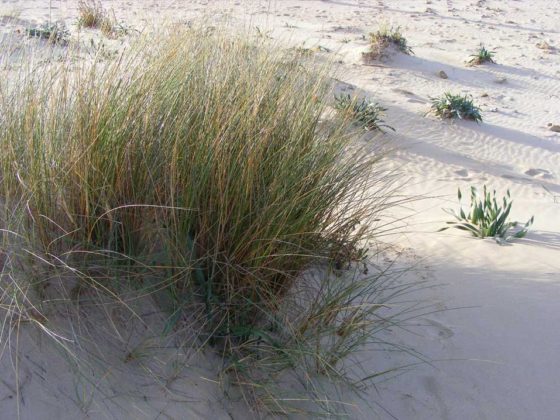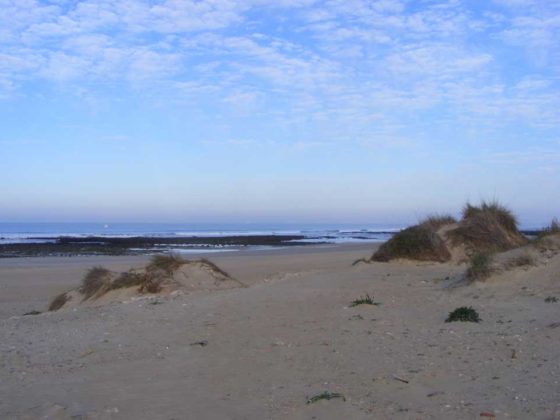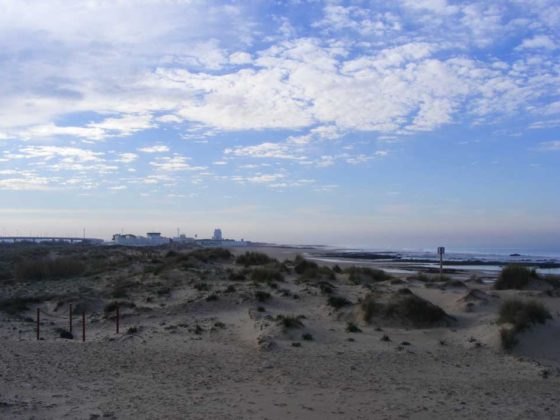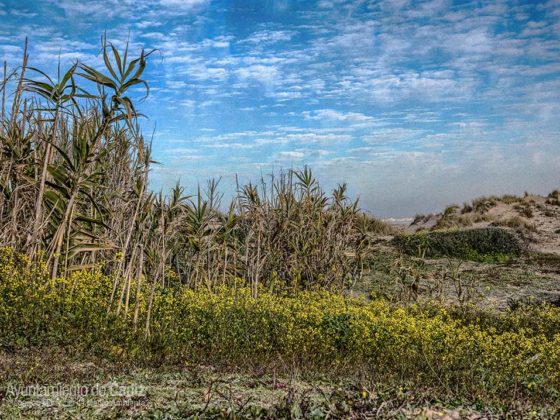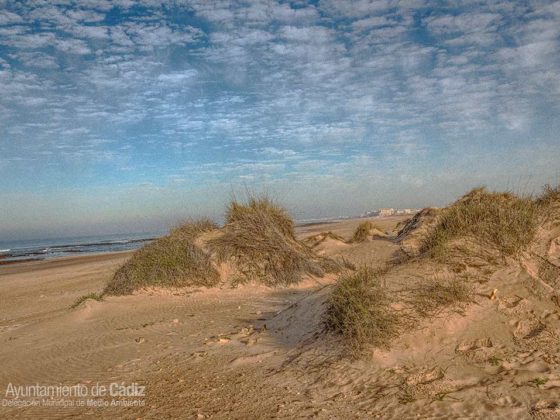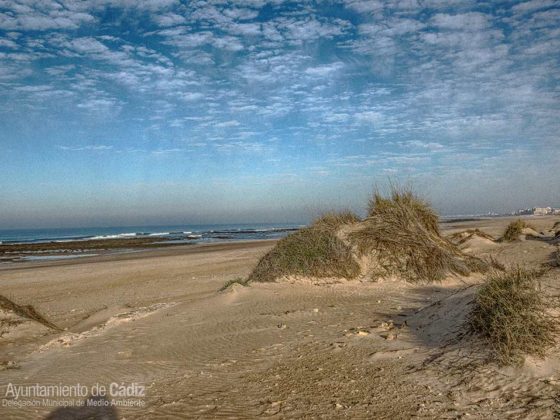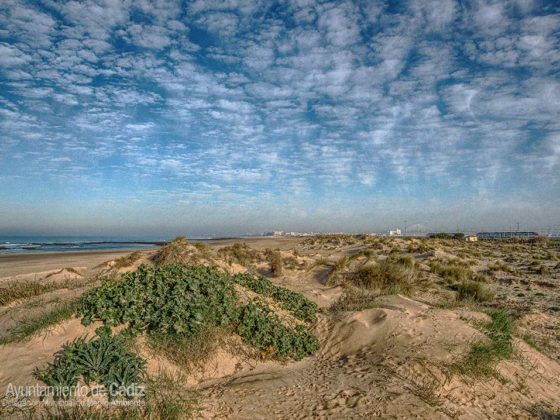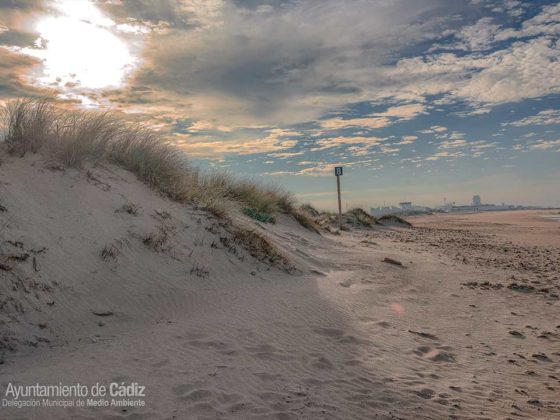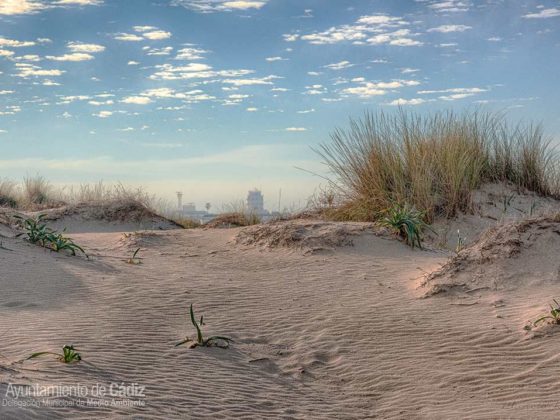The Coastal Dune and Cortadura Beach
Although Cortadura Beach was not included within the protected territory as a Nature Park, it is an almost virgin beach, being the only one of the municipality that keeps the category of “natural” in the stretches of El Chato, Santibáñez and Matagorda. It is located parallel to the CA-33 road, forming the sandy barrier, tombolo or neck of land that separates the inner part of the Bay of Cadiz from the Atlantic Ocean and that connects Cadiz with San Fernando. This is where the Augusta Road was, the longest Roman road in Hispania, which ran from the Pyrenees to Cadiz bordering the Mediterranean.
It starts at the end of Cadiz next to the walls of the Cortadura which were the outer limit of the defenses of the city from the seventeenth to the nineteenth century. It extends along the left bank of the CA-33 road (in ascending kilometric direction in the direction of Cadiz), until reaching the Caño of the River Arillo that divides the municipalities of Cadiz and San Fernando.
It is the most extensive of the municipality, with a length of 3900 metres and a dry beach width of about 60 metres. It is considered “urban”, in its section from the walls of Cortadura to the Chato and as a “virgin beach”, from that to the Caño of the River Arillo, a stretch that includes the beaches known as Santibanez and Torregorda (this access prohibited because of the military facilities of the Torregorda Test Centre), where the municipality ends.
Due to the presence of unique habitats and spaces of interest for citizens, the Provincial Council of Cadiz included these zones within its Plan for the Protection of the Physical Environment in 2007, as a Litoral Complex of Environmental Interest.
It is formed by a line of dunes, a wide intertidal zone and an extensive rocky platform that runs along the coast that is exposed at low tide. The sand dune consists of a primary dune on which characteristic vegetation of active sandstones has established, such as marram grass (Ammophila arenaria), the European searocket (Cakile maritima) and the common saltwort (Salsola kali) in the areas closest to the sea. Other species are found further inland, such as the couchgrass (Elymus faratus), the eryngo (Eryngium maritimus) and the daffodil (Pancratium maritimum), among others. After the primary dune, there is a relatively active secondary dune area, where the species richness increases and exotic species appear, such as the Cape Fig (Carpobrotus edulis) and giant cane (Arundo donax). In this inner zone there are several artificial depressions in the shape of a bucket, which balance the sands, stabilised with exotic vegetation, where other species are established, such as the sharp rush (Juncus acutus). Throughout the entire dune area, there are several walkways that reach the beach from the parking area, of which only three are elevated. However, the entire dune appears very fragmented by the passage of beach-goers through the area.
Among the fauna that can be found in the area of dunes, you can find the Spiny-footed Lizard (Acanthodactylus erythrunus), the Bedriaga’s Skink (Chalcides bedriagai) or the Common Chameleon (Chamaeleo chamaeleon), species of the Iberian fauna being the most threatened. They are located in the pine forests and in the dune areas. In the area of shore, you can observe species of waders such as the Kentish Plover (Charadrius alexandrinus), several species of sandpipers, Eurasian Oystercatchers (Haematopus ostralegus), terns like the little Terns (Sterna albifrons), the Sandwich Tern (Sterna sandvicensis) or the Capsian Tern (Sterna caspia). In the area of rocks at low tide, the Black Shag (Phalacrocorax carbo), the Caspian Gull, (Larus michahellis), Black-headed Gull (Larus ridibundus), Slender-billed Gull (Larus genei), Lesser black-backed Gull (Larus fuscus) or even the Audouin’s Gull (Larus audouinii) can be found.
The City Council of Cadiz has been developing a plan for the preservation of the structure and functioning of the natural ecosystems of Cortadura Beach for years. Their plan to see this through, is by the eradication of invasive alien vegetation that is displacing native vegetation, such as the Cape Fig (Carpobrotus edulis). The planting of native species within these dune ecosystems will see the limitation of excessive pressure from visitors in the most fragile areas.
As for the historical heritage of this area, it´s worth highlighting the Fort of Cortadura (19th century), the last great bastion fortification raised for the defence of the city of Cadiz during the War of Independence against the French (1808-1814). El Ventorrillo del Chato is an old staging post of the 18th century, where a battery of cannons was installed during the siege of the City of Cadiz in 1812, to harass the enemy that fired from El Trocadero. It was converted and is currently a restaurant.
